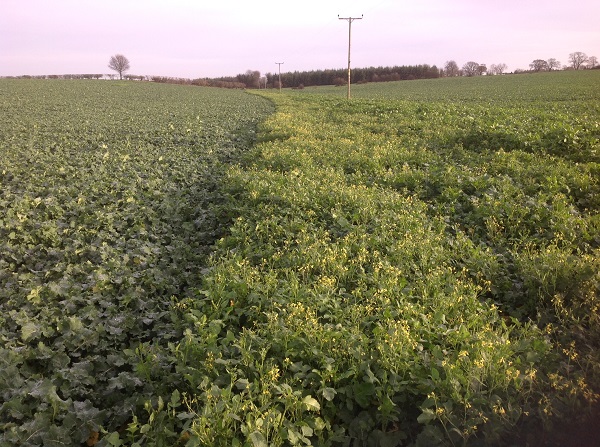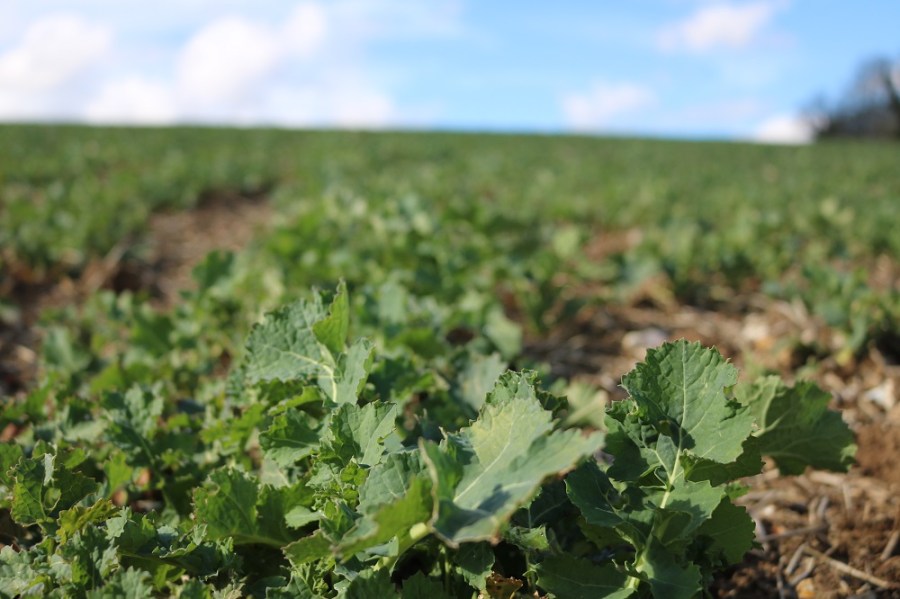The seed trade is predicting the area of Clearfield oilseed rape could double for the fourth year in a row this autumn, bringing its area to around 20% of the national crop. CPM finds out why.
Managing up-front cost and improving the crop’s chance of establishment has become a key priority.
By Rob Jones
There’s a quiet revolution going on when it comes to oilseed rape varieties and it’s being led by growers. Many have thrown the AHDB Recommended List out of the window and are putting lower risks ahead of bumper yields.

The Clearfield system provides a solution to cruciferous weeds and volunteer OSR which can both affect the crop’s erucic acid levels.
OSR is a crop plagued by uncertainty during its establishment phase. Combine this with a large up-front herbicide spend and for many growers, it’s become a gamble, particularly since the loss of neonicotinoid seed treatments. But some feel that all changed with the introduction of the Clearfield trait.
Interest from growers across the country has grown to such an extent that leading merchants foresee the current 60,000ha of OSR varieties with the trait increasing to as much as 120,000ha this autumn. Depending on the level of OSR planting this autumn, this would give it a market share of 17-20%.
Many growers who dipped their toe in the water for the first time last autumn are going completely Clearfield this time around, according to Openfield’s head of seed, Lee Bennett. “We’re also getting 100% Clearfield orders from large businesses that have never grown it before,” he says.
But why is the trait gaining in popularity? According to Lee, it’s because growers like waiting until they know they have a crop and knowing what weeds they need to control before spending on herbicides.
“They like having the most reliable control of cruciferous weeds and OSR volunteers. And they like the extra protection they get against erucic acid contamination with a Clearfield variety,” he says.
“Based on our seed orders to date and all the indications from those still to place them, I have no doubt Clearfield plantings will increase very substantially once again this autumn, with DK Imperial CL our biggest seller. I see 20% of the market as a very realistic expectation.”
David Waite and his seed management colleagues at Frontier are finding exactly the same thing, with early orders for their main variety, DK Impression CL, and interest in growing Clearfield at an all-time high. So much so that that they expect the increased stocks of seed they have for this autumn may sell out before the current OSR crop is harvested.
“Worries over erucic acid contamination are a major factor behind the increased demand we’re experiencing,” he explains. “Even people who have never grown HEAR in the past have been having problems at the crush – presumably as a result of cruciferous weed contamination, farm-saved seed or both.
“The Clearfield system is an ideal solution here, especially with the sort of cast-iron seed quality assurances and the free pre-movement erucic acid testing of harvested crops offered by Dekalb. It provides the ultimate in risk management for anyone with any worries over erucic acid.”
Also reporting growing demand for Clearfield on all sides and anticipating further major growth in the sector for 2018/2019 is Andrew Bourne of Kent-based seed specialists, T Denne & Sons.
“I can certainly see UK plantings hitting 100,000ha this autumn as growers do everything they can to reduce their establishment, management and crop marketing risks,” he says.
“Managing up-front cost of winter OSR growing and improving the crop’s chance of establishment has become a key priority to minimise the risks of crop failure from a dry autumn or flea beetle attack.
“It’s also Important to overcome volunteer OSR and cruciferous weed problems which can compromise spraying programmes, canopy management and desiccation timing. Planting 55 seeds/m2 of a variety with the traits you want, but actually growing 100 plants/m2 or more of a mixture of plants with very different and less desirable qualities, doesn’t make for effective or economic use of expensive crop inputs. Equally, the last thing you want when sending your crop to the crush is a hefty claim for high erucic acid levels.
“The popularity of Clearfield is growing by leaps and bounds as more and more growers see these advantages for themselves or learn of them from others and appreciate they no longer need to sacrifice yield for the character.”
Agrii seed manager, Matt Richardson insists the tremendous progress made in improving both the yield and agronomics of Clearfield varieties is every bit as significant in the continued expansion of the system.
“The first CL variety to join the AHDB Recommended List in 2013/14, DK Imagine CL, was well off the pace in its gross output and had a decidedly average agronomic package,” he recalls. “It was a breakthrough, allowing OSR to be grown economically on land with serious charlock or runch problems, but that was about all,” he says.
“In complete contrast, our growers are finding today’s varieties very much on a par with mainstream ‘double lows’ in performance in the field. Both DK Imperial and new stablemate DK Impressario have strong phoma and light leaf spot resistance ratings, are vigorous to establish with rapid development in the autumn and have pod shatter resistance. Combine this with all the advantages of Clearfield and what’s not to like? ”
At Hubbards Seeds, Barnaby Patchett is also finding Clearfield demand is higher than last season but urges growers to be discerning in their variety choice.
“As the system has become more popular the number of CL varieties to choose from has increased dramatically,” he points out.
“You certainly don’t have to sacrifice output these days to take advantage of imazamox resistance. Nor do you have to accept less good disease resistance, slower autumn development or the pod shatter resistance that can be so useful with Clearfield varieties to minimise volunteers as much as maximise yield.”
Latest grower study supports Clearfield growth
Seed trade expectations could underestimate the growth in the UK Clearfield OSR area this autumn, according to the latest national grower intelligence.
A late-June OSR establishment study run independently for leading breeder Dekalb, gathered information from more than 120 winter OSR growers across the country and backs-up the seeds-men prediction of doubling the Clearfield acreage from its current level.
The study involved growers from 21 counties, harvesting a total of more than 11,500ha of winter OSR this season. Their planting intentions suggest a further noticeable year-on-year rise in the national OSR area is on the cards for harvest 2019, with Clearfield accounting for the vast majority of this increase.
The figures indicate Clearfield plantings are set to rise by 110% from 2018 levels – the majority of current growers planning to significantly expand their crops this autumn and nearly twice as many farms overall intending to plant CL varieties. At the same time, more growers are looking to go 100% Clearfield.
“As ever, the extent to which these intentions will translate into actual plantings will depend, more than anything else, on the weather,” notes Dekalb northwest Europe commercial manager, Geoff Hall. “But they clearly indicate grower confidence both in OSR in general and in the sort of high performance, high reliability Clearfield varieties in particular.
“European OSR market prospects have been noticeably stronger of late and analysts are more positive about the future than they’ve been for a while. Alongside this, the lack of yield lag and lower establishment and marketing risks associated with our leading Clearfield varieties are clearly proving an obvious attraction for growers.”




